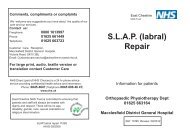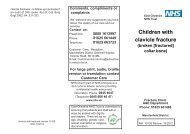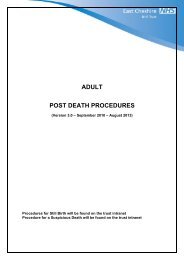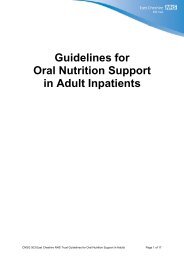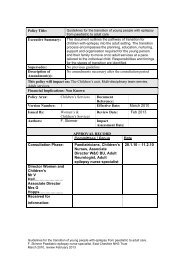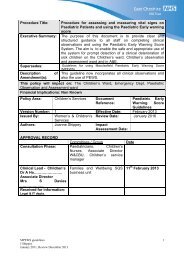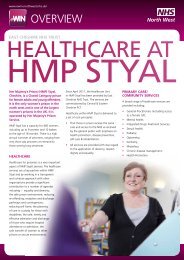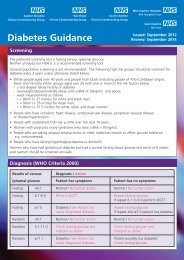Do Not Attempt Cardiopulmonary Resuscitation 1669.pdf
Do Not Attempt Cardiopulmonary Resuscitation 1669.pdf
Do Not Attempt Cardiopulmonary Resuscitation 1669.pdf
- No tags were found...
Create successful ePaper yourself
Turn your PDF publications into a flip-book with our unique Google optimized e-Paper software.
ContentsPage4 1.0 Policy Statement4 2.0 Background4 3.0 Organisational Responsibilities5 4.0 Application6 5.0 Who Makes the Decision?8 6.0 <strong>Do</strong>cumentation and Communication8 7.0 Endorsement and Review of a DNACPR Order9 8.0 Validation of a DNACPR Order9 9.0 Other Considerations9 10.0 Implementation and Access to this Policy10 11.0 Measuring Performance and Audit Completion10 12.0 DNACPR Policy Review10 13.0 Equality and Diversity11 References12 Appendix 1 – DNACPR Order (Red Form)14 Appendix 2 – Equality Analysis (Impact Assessment)<strong>Do</strong> <strong>Not</strong> <strong>Attempt</strong> <strong>Cardiopulmonary</strong> <strong>Resuscitation</strong> Policy<strong>Resuscitation</strong> OfficerVersion 5.0 May 123
1.0 Policy Statement<strong>Cardiopulmonary</strong> resuscitation (CPR) may be attempted on any individual for whom cardiac orrespiratory function ceases. Such events are inevitable as part of dying. CPR can theoreticallybe used on every individual prior to death. However, in some people this would beinappropriate, futile or against the individual’s wishes. It is therefore essential to distinguishthose patients for whom CPR would be inappropriate.2.0 BackgroundThe factors surrounding a decision whether or not to initiate CPR involve complex clinicalconsiderations and emotional issues. The decision for CPR of one patient may be inappropriatein a superficially similar case.In conjunction with the General Medical Council (GMC) a joint statement by the British MedicalAssociation (BMA), the Royal College of Nursing and the <strong>Resuscitation</strong> Council (UK) wasissued in October 2007. Recommended standards for recording DNAR (<strong>Do</strong> <strong>Not</strong> <strong>Attempt</strong><strong>Resuscitation</strong>) decisions were issued in 2009 by the <strong>Resuscitation</strong> Council. The GMC alsopublished guidelines – Treatment and care towards the end of life: good practice in decisionmaking – in July 2010.The aforementioned guidelines have been used to prepare this document.This policy respects the individual’s absolute right to life in accordance with the Human RightsAct (1998) and the Mental Capacity Act (2005).Copies of this policy are circulated to all wards and clinical departments within the Acute settingof East Cheshire NHS Trust. The policy is also available on the Trust’s website. Within the inpatientareas information leaflets (Ref: 10172) are available to all who may wish to consult them,including patients, families and carers (“Decisions about <strong>Cardiopulmonary</strong> <strong>Resuscitation</strong>”).Further information about these issues can be obtained from the <strong>Resuscitation</strong> Officer.3.0 Organisational Responsibilities3.1 Chief ExecutiveHas ultimate responsibility for the implementation and monitoring of this policy. Thisresponsibility may be delegated to an appropriate colleague, for example the Medical Director.3.2 All DirectorsDirectors are responsible for the implementation of this policy; the Medical Director isresponsible for ratifying this policy.3.3 The <strong>Resuscitation</strong> CommitteeThe <strong>Resuscitation</strong> Committee is responsible for the development, consultation and approvalprocess of this policy. The committee is also responsible for reviewing the policy to ensure thatit follows the latest best practice.3.4 The <strong>Resuscitation</strong> OfficerThe <strong>Resuscitation</strong> Officer is a full member of the <strong>Resuscitation</strong> Committee and is responsible formonitoring compliance with this policy.<strong>Do</strong> <strong>Not</strong> <strong>Attempt</strong> <strong>Cardiopulmonary</strong> <strong>Resuscitation</strong> Policy<strong>Resuscitation</strong> OfficerVersion 5.0 May 124
3.5 Ward/Department/Service Managers including ConsultantsManagers are responsible for ensuring relevant staff have access to the policy, are trained in itsimplementation and are aware of a <strong>Do</strong> <strong>Not</strong> <strong>Attempt</strong> <strong>Cardiopulmonary</strong> <strong>Resuscitation</strong> (DNACPR)decision which has been appropriately documented.4.0 Application4.1 For many patients the likelihood of cardio-respiratory arrest is small and no clinicaldecision is made in advance of such an event. If cardio-respiratory arrest does occurunexpectedly, CPR should be attempted.4.2 In some people there is an identifiable risk of cardiac or respiratory arrest, such as anunderlying incurable condition (such as advanced cancer), the history (such as recentmyocardial infarction or stroke), or current clinical condition (such as severe sepsis). If there is arisk of cardiac or respiratory arrest a decision should be made in advance about theappropriateness of CPR whenever possible.4.3 A DNACPR order (Red Form) applies only to in-patients of East Cheshire NHS Trust.The order (see appendix 1) refers solely to cardiopulmonary resuscitation; i.e. in the event of acardiac or respiratory arrest no attempts at cardiopulmonary resuscitation will be made. All othertreatment and care, where appropriate, shall not be precluded or be influenced by a DNACPRdecision.4.4 The decision is only valid during the patient’s current in-patient admission and isautomatically revoked on discharge from hospital. If still applicable, another DNACPR decisionmay be made on subsequent admissions. A new form will need to be completed for each inpatientepisode.4.5 The decision not to undertake CPR on a patient is taken following appropriateconsideration of the likely clinical outcome and the patient’s known wishes. The followingguidelines may support a decision not for CPR:4.5.1 Where attempting CPR would not restart the patient’s heart and breathing.If the health care team is as certain as it can be that attempting CPR would notrestart the patient’s heart and breathing because of the patient’s clinicalcondition, the patient cannot gain any clinical benefit from an attempt. Thisshould be a team decision and based on clinical assessment of the patient’scondition and up-to-date clinical guidelines and in the patient’s best interests.4.5.2 Where there is no benefit in restarting the patient’s heart and breathing.If the patient is terminally ill and death is inevitable within a short period of time,then that person should be allowed to die naturally with full comfort and palliativemeasures.4.5.3 Where the expected benefit is outweighed by the burdens of resuscitation.Where CPR may be successful in restarting the patient’s heart and breathing,and thus prolong the patient’s life, the benefits to be gained from the prolongationof life must be weighed against the burdens to the patient of the treatment.Again, this should be a team decision and based on clinical assessment of thepatient’s condition and up-to-date clinical guidelines and in the patient’s bestinterests.<strong>Do</strong> <strong>Not</strong> <strong>Attempt</strong> <strong>Cardiopulmonary</strong> <strong>Resuscitation</strong> Policy5<strong>Resuscitation</strong> OfficerVersion 5.0 May 12
4.5.4 Where the patient with capacity has asked that CPR NOT be attempted.It is well established in law and ethics that adults with capacity have the right torefuse any medical treatment, even if that refusal may result in death.4.5.5 Where a patient has a valid Advance Directive clearly refusing cardiopulmonaryresuscitation. If there is any doubt about the validity of an AdvanceDirective, the Trust’s Legal Services should be contacted as soon as possible.4.6 If a patient or a proxy decision maker is requesting CPR in the case of a cardiorespiratoryarrest, but the healthcare team believes that this would not re-start the heart andbreathing, this should be explained to the patient in a sensitive way. These discussions may bedifficult and where possible should be carried out by experienced senior clinicians. If thedecision is not accepted, then a second opinion should be offered.4.7 If a patient is to undergo a surgical or other invasive procedure (such as cardiaccatheterisation, pacemaker insertion) then it may be appropriate to suspend a DNACPR orderfor the duration of the procedure and monitored recovery. Under these circumstances, the riskof precipitating an arrhythmia is increased, but the arrest is much more likely to be quickly andreadily reversible. Under these circumstances please adhere to the following: Such a decision must be reviewed before the procedure with the patient or theirappointed representative if they lack capacity, as part of the consent process.If a patient wishes an advance decision refusing CPR to remain valid during such aprocedure and this would significantly increase the risks, and the clinician believesthat it would not be safe or successful with the DNACPR order in place, it would bereasonable not to proceed. The agreed DNACPR management option must be documented and communicatedto all the healthcare staff managing the patient during the procedure and recovery.5.0 Who makes the decision?5.1 The overall clinical responsibility for decisions about CPR, including DNACPR decisions,rests with the Consultant (or equivalent) in charge of the patient’s care. When a decision needsto be made urgently, this should be by the most senior registered doctor available (FoundationYear 2 (F2) or Senior House Officer (SHO), or above) and endorsed before the end of the nextday by the most senior doctor responsible for the patient’s care, i.e. Consultant or doctor withequivalent responsibility. If he/she is unable to attend to sign personally, this may be delegatedto a Registrar/Middle Grade doctor, who has seen and reviewed the patient and discussed theDNACPR decision with the Consultant (or equivalent) by telephone communication; directlyafter the telephone communication the Consultant’s (or equivalent) name and position must beentered on the DNACPR Order by the Registrar/Middle Grade doctor.5.2 Decisions should be made after discussion with the patient unless they do not wish totalk about it, lack mental capacity or have a valid advance directive. The Trust booklet on CPRshould be used and given to the patient with capacity at the time of the discussion. The patient’swishes must be taken into account when making a decision. It is not appropriate to discussresuscitation decisions with a patient who is dying unless they want this conversation.5.3 If the patient has difficulty understanding or communicating decisions, due to sensoryimpairment, physical disability, lack of understanding of English or other reason, then allreasonable effort should be made to assist them in all relevant discussions. Please refer to the<strong>Do</strong> <strong>Not</strong> <strong>Attempt</strong> <strong>Cardiopulmonary</strong> <strong>Resuscitation</strong> Policy<strong>Resuscitation</strong> OfficerVersion 5.0 May 126
Trust’s Interpreting Policy for information.5.4 If the patient lacks mental capacity and has an appointed health proxy (Personal WelfareLasting Power of Attorney or a Court Appointed Deputy) then decisions about resuscitation mustbe discussed with them. A Welfare Attorney may be able to refuse life-sustaining treatment onbehalf of the patient, if this power is included in the original Lasting Power of Attorney. Such arepresentative cannot insist upon CPR if it is felt by the medical team not to be in the patient’sbest interests. If the patient has an Independent Mental Capacity Advocate (IMCA), then thereshould be discussion before a decision is made. If there is disagreement then a second opinionshould be obtained. Please refer to the Mental Capacity Act web page on the Trust’s website formore information. NB: A referral for an IMCA must be made in the situations whereby a patientlacks capacity and does not have friends or relatives to consult; please see the Cheshire IMCAService IMCA Referral Information and Form and the One Minute Guide: When to instruct anIMCA for more details.5.5 If a patient decides they do not wish to have CPR attempted, this should be documentedcarefully in the medical record. Unless this decision is signed by the patient and the signature iswitnessed, it is unlikely to meet the legal criteria for a valid advance decision. Thus somepatients may prefer to make a formal, written advance decision. Please note the following: If the patient is unable to write, someone else should write it down for them. Forexample, a family member can write down the decision on their behalf, or ahealthcare professional can record it in the person’s healthcare notes. If the patient is unable to sign, they can direct someone to sign on their behalf in theirpresence. This must be witnessed. The witness must then sign to indicate that theyhave witnessed the nominated person signing the document in front of the patientmaking the advance decision (see the Mental Capacity Act Code of Practice,Chapter 9 – “What does the Act say about advance decisions to refuse treatment?”)5.6 At the time of the discussion with the patient ensure that a record of the assessment ofcapacity is also documented in the medical notes.5.7 If a patient is admitted to hospital with an advance decision refusing CPR already inplace, this must be assessed for validity and applicability (see the Mental Capacity Act Code ofPractice, Chapter 9 – “What does the Act say about advance decisions to refuse treatment?” formore detail). An advance decision to refuse life-sustaining treatment must meet specificrequirements: It must be put in writing. If the person is unable to write, someone elseshould write it down for them (see 5.5 above) The advance decision must include a clear, specific written statement fromthe patient making an advance decision to refuse CPR even if life is at risk. If this statement is made at a different time or in a separate document to theadvance decision, the patient making the advance decision (or someonethey have directed to sign) must sign it in the presence of a witness, whomust also sign it.5.8 If the patient lacks capacity a DNACPR decision should normally be discussed with therelatives, unless such discussion has previously been refused by the patient when they hadcapacity. However, relatives cannot give or withhold consent for the DNACPR decision.<strong>Do</strong> <strong>Not</strong> <strong>Attempt</strong> <strong>Cardiopulmonary</strong> <strong>Resuscitation</strong> Policy<strong>Resuscitation</strong> OfficerVersion 5.0 May 127
5.9 Occasionally discussion with patient and/or family members may not be appropriate andin these cases the doctor should use his/her discretion. An example would be a patient who is inthe last days of life, at the end of a terminal illness, and the family are aware he/she is dying. Anexplanation for not involving the patient, or relatives, in the decision-making process should bedocumented on the DNACPR Order (Red Form) – e.g. patient lacks capacity and relatives notavailable.5.10 The initial decision not to provide CPR should be made by the most senior doctoravailable in charge of the patient’s care (i.e. registered doctor – F2 or SHO grade, or above)after discussion with the registered nurse responsible for the patient’s care and other membersof the multidisciplinary team involved in the patient’s care.5.11 DNACPR orders should also be recorded for patients expected to die imminently inwhom resuscitation could not be successful. If this is not done, first responders are obliged toinitiate a resuscitation attempt in accordance with the Trust CPR Policy.5.12 In cases of expected death where it has been recorded that the patient is not forresuscitation, designated nurses with the appropriate training may verify the patient’s death inthe absence of a doctor.6.0 <strong>Do</strong>cumentation and Communication6.1 The DNACPR order is printed on a single sheet of Red A4 paper as shown in appendix1. The form must be completed in full, and no abbreviations are permitted. It must be dated andsigned with the doctor’s name and position (section 6). The guidelines for the use of the formare printed on the reverse.6.2 The doctor recording the decision should insert this form securely into the front of thepatient’s medical records and document the decision in the case notes. If applicable stateclearly what was discussed and agreed with the patient or health proxy.6.3 It is the responsibility of this doctor to ensure the decision is communicated to theregistered nurse responsible for the patient’s care. This nurse should be involved in the decisionmaking process and must enter their name, signature, position and the date in section 5 of theRed Form.6.4 It is the duty of this nurse to ensure that this decision is communicated to all otherrelevant members of staff and documented in the nursing notes.7.0 Endorsement and Review of a DNACPR Order7.1 The DNACPR order must be reviewed and endorsed before the end of the next day bythe most senior healthcare responsible for the patient’s care, i.e. Consultant or doctor withequivalent responsibility. If he/she is unable to attend to sign personally, this may be delegatedto a Registrar/Middle Grade doctor, who has seen and reviewed the patient and discussed theDNACPR decision with the Consultant (or equivalent) by telephone communication; directlyafter the telephone communication the Consultant’s (or equivalent) name and position must beentered on the DNACPR Order by the Registrar/Middle Grade doctor.<strong>Do</strong> <strong>Not</strong> <strong>Attempt</strong> <strong>Cardiopulmonary</strong> <strong>Resuscitation</strong> Policy<strong>Resuscitation</strong> OfficerVersion 5.0 May 128
7.2 A DNACPR decision should be reviewed, by the treating doctor, when clinicallyappropriate, e.g. following any significant change in the patient’s condition. Out of hours this willbe a doctor from the team responsible for that patient’s care. A fixed review date is notrecommended.7.3 Whenever the decision is reviewed and the instruction is upheld, this must be recorded inthe medical record by the relevant registered doctor (i.e. F2 or SHO grade, or above); name,signature and date must be entered. It is not usually necessary to discuss CPR with the patienteach time the decision is reviewed. However, where a patient has previously been informed of adecision and it subsequently changes, they should be informed of the change of decision andthe reason for it, where appropriate. The details of the decision and discussion should berecorded in the medical record.7.4 If the decision is cancelled, and when the patient is discharged from hospital, the DNACPRform should be crossed through with 2 diagonal lines in black ballpoint ink and “CANCELLED”written clearly between them. The date, name and signature of the healthcare professionalcancelling the order must also be clearly documented. The form should then be removed fromthe front of the patient’s medical records and filed chronologically with the appropriate medicalnotes. If the patient remains in hospital it is vital that the nursing staff are informed of thisdecision immediately and details clearly recorded in the medical record.8.0 Validation of a DNACPR Order8.1 The decision not to resuscitate a patient is valid for the current in-patient admission only,or for the period of time documented at the last review if specified, unless the order is cancelled.8.2 Any DNACPR orders recorded in the medical or nursing notes relating to a previousadmission are no longer valid.8.3 If the decision is appropriate for a subsequent admission, another DNACPR form must becompleted, signed, dated and filed as above.8.4 If a patient with a valid DNACPR order is transferred from/to Aston Unit (Congleton WarMemorial Hospital) the order remains valid and this policy still applies.9.0 Other Considerations9.1 If, in the event of a cardiopulmonary arrest, the first responders are unsure of the patient’sresuscitation status then a resuscitation attempt must be commenced until clarification isobtained.9.2 This policy is under constant review and amendments may be required according to auditfindings.10.0 Implementation and Access to this Policy10.1 All Ward/Departmental/Service Managers including Consultants will be sent a copy of thispolicy and must ensure that relevant staff have access to the policy and are appropriatelytrained in its implementation.<strong>Do</strong> <strong>Not</strong> <strong>Attempt</strong> <strong>Cardiopulmonary</strong> <strong>Resuscitation</strong> Policy<strong>Resuscitation</strong> OfficerVersion 5.0 May 129
10.2 This policy will be uploaded onto the Trust’s website.11.0 Measuring Performance and Audit Completion11.1 Please refer to the <strong>Do</strong> <strong>Not</strong> <strong>Attempt</strong> <strong>Cardiopulmonary</strong> <strong>Resuscitation</strong> Policy ComplianceMonitoring Tool for details relating to measuring performance and audit requirements.12.0 DNACPR Policy Review12.1 This policy will be reviewed every 3 years by the <strong>Resuscitation</strong> Committee or more oftenif national guidance changes.13.0 Equality and Diversity13.1 This policy has been impact assessed with regards to equality and diversity and thereare no areas in the policy that contravene equality and diversity guidance (see appendix 2).<strong>Do</strong> <strong>Not</strong> <strong>Attempt</strong> <strong>Cardiopulmonary</strong> <strong>Resuscitation</strong> Policy<strong>Resuscitation</strong> OfficerVersion 5.0 May 1210
ReferencesA Joint Statement from the British Medical Association, the <strong>Resuscitation</strong> Council (UK), and theRoyal College of Nursing. <strong>Resuscitation</strong> Council (UK) 2007. Athttp://www.resus.org.uk/pages/dnar.htm (accessed 09/04/12)Recommended standards for recording "<strong>Do</strong> not attempt resuscitation" (DNAR) decisions.<strong>Resuscitation</strong> Council (UK) 2009. Athttp://www.resus.org.uk/pages/DNARrstd.htm (accessed 09/04/12)Treatment and care towards the end of life: good practice in decision making. General MedicalCouncil, London (2010). Athttp://www.gmc-uk.org/Treatment_and_care_towards_the_end_of_life_0510_32609298.pdf(accessed 09/04/12)Department of Health. Mental Capacity Act 2005. Athttp://www.dh.gov.uk/en/SocialCare/Deliveringadultsocialcare/MentalCapacity/index.htm(accessed 09/04/12)Mental Capacity Act Code of Practice. The Stationery Office, London (2007). Athttp://trustnet/MCA%20Code%20of%20Practice.pdf (accessed 09/04/12)<strong>Do</strong> <strong>Not</strong> <strong>Attempt</strong> <strong>Cardiopulmonary</strong> <strong>Resuscitation</strong> Policy<strong>Resuscitation</strong> OfficerVersion 5.0 May 1211
Appendix 1Revised May 2012DO NOT ATTEMPT CARDIOPULMONARY RESUSCITATION (DNACPR)SEE REVERSE FOR GUIDANCE NOTES TO ASSIST WITH COMPLETING THIS FORMName _________________________________ Date of DNACPR order: _______________Address _________________________________Date of birth ____________________________ Consultant ____________________________NHS or hospital number _____________________ Ward ____________________________In the event of cardiac or respiratory arrest no attempts at cardiopulmonary resuscitation (CPR) will be made.All other appropriate treatment and care will be provided.1 <strong>Do</strong>es the patient have capacity to make & communicate decisions about CPR? YES / NOIf “YES” go to box 2If “NO” to the best of your knowledge are you aware of a valid advance decision refusing YES / NOCPR which is relevant to the current condition?If “YES” go to box 4 (if appropriate) then complete boxes 5 and 6If “NO” has the patient appointed a Welfare Attorney (as part of a lasting Power of Attorney)to make decisions on their behalf? If “YES” they must be consultedIf “NO” any other persons involved in patient’s welfare must be consulted if available.If no such person exists then an IMCA must be instructed. IMCA instructed?YES / NOYES / NOAll decisions must be made in the patient’s best interests and comply with current law. Go to box 22 Summary of the main clinical problems and reasons why CPR would be inappropriate,unsuccessful or not in the patient’s best interests:3 Summary of communication with patient (or Welfare Attorney). If this decision has not beendiscussed with the patient or Welfare Attorney state the reason why:4 Summary of communication with patient’s relatives or friends and identify their names. If notcommunicated, state the reason why:5 Registered nurse responsible for patient’s care:Name _______________________ Signature ____________Position _____________________ Date ________________Other professionals contributing tothis decision (list):6 Healthcare professional (i.e. Registered <strong>Do</strong>ctor, F2/SHO or above) completing this DNACPR order:(PRINT) Name _____________________________________ Position _________________________Signature _________________________________________ Date ___________ Time ___________7 Endorsement (required before the end of the next day) by Consultant or equivalent:(PRINT) Name _____________________________________ Position _________________________Signature _________________________________________ Date ___________ Time ___________Or, if after telephone discussion, endorsement is delegated to Registrar/Middle Grade <strong>Do</strong>ctor byConsultant/equivalent, give details below:Consultant/equivalent: (PRINT) Name ____________________________ Position _______________Registrar/Middle Grade <strong>Do</strong>ctor: (PRINT) Name _____________________ Position _______________Signature _______________________________ Date of discussion: ___________ Time _________<strong>Do</strong> <strong>Not</strong> <strong>Attempt</strong> <strong>Cardiopulmonary</strong> <strong>Resuscitation</strong> Policy<strong>Resuscitation</strong> OfficerVersion 5.0 May 1212
Guidance notes to assist with completing this formThis form should be completed legibly in black ball point ink. All sections should be completed.The patient’s full name, date of birth and address should be written clearly or addressograph attached.The date of writing the order should be entered.An acceptable entry in the clinical notes would be “In the event of cardiac or respiratory arrest patient isnot for <strong>Cardiopulmonary</strong> <strong>Resuscitation</strong>” (do not use abbreviations).This order will be regarded as “INDEFINITE” for this hospital admission unless it is clearly cancelled afterreview.The order should be reviewed when clinically appropriate - e.g. a change in the patient’s condition. A fixedreview date is not recommended.If after review, the “DNACPR” is cancelled, the form should be crossed through with 2 diagonal lines inblack ball-point ink and “CANCELLED” written clearly between them, signed, name printed and dated by thehealthcare professional responsible for cancelling the order.On discharge from hospital the order must be cancelled by the named nurse or doctor responsible for thepatient’s care using the instructions detailed in the bullet point above.1. Capacity / advance decisions:Record the assessment of capacity in the clinical notes. Ensure that any advance decision is valid for thepatient’s current circumstances.16 and 17-year-olds: Whilst 16 and 17-year-olds with capacity are treated as adults for the purposes ofconsent, parental responsibility will continue until they reach age 18. Legal advice should be sought via theTrust Legal Department in the event of disagreements on this issue between a young person of 16 or 17and those holding parental responsibility.2. Summary of the main clinical problems and reasons why CPR would be inappropriate, unsuccessfulor not in the patient’s best interests: Be as specific as possible.3. Summary of communication with patient:Whenever possible and appropriate this decision should be discussed with the patient. State clearly whatwas discussed and agreed. The CPR information booklet should be given to the patient at this time. If thisdecision was not discussed with the patient, state the reason why this was inappropriate.4. Summary of communication with patient’s relatives or friends:If the patient does not have capacity, their relatives or friends should be consulted. However, relativescannot give or withhold consent for the DNACPR decision. If the patient has made a Lasting Power ofAttorney, appointing a Welfare Attorney to make decisions on their behalf, that person must be consulted.A Welfare Attorney may be able to refuse life-sustaining treatment on behalf of the patient, if this power isincluded in the original Lasting Power of Attorney.If the patient has capacity ensure that discussion with others does not breach confidentiality.State the names and relationships of relatives or friends or other representatives with whom this decisionhas been discussed. More detailed description of such discussion should be recorded in the clinical noteswhere appropriate.5. Names of members of nursing team and other professionals contributing to this decision:State the names and positions of professionals contributing to this decision. The registered nurseresponsible for patient’s care is to sign and date the form at the time of the decision being made. It is theduty of this nurse to ensure that this decision is communicated to all other relevant members of staff anddocumented in the nursing notes.6. Healthcare professional completing this DNACPR order:This should be the most senior healthcare professional immediately available (i.e. Registered <strong>Do</strong>ctor,Foundation Year 2 (F2) or Senior House Officer (SHO) grade or above). This doctor must ensure thedecision is documented in the case notes.7. Endorsement:The decision must be endorsed before the end of the next day by the most senior healthcare professionalresponsible for the patient’s care (i.e. Consultant or doctor with equivalent responsibility). If unable to attendto sign personally, this may be delegated to a Registrar/Middle Grade doctor, who has seen and reviewedthe patient and discussed it with the Consultant or equivalent. Details requested on the form must beentered at the time the decision is being made.<strong>Do</strong> <strong>Not</strong> <strong>Attempt</strong> <strong>Cardiopulmonary</strong> <strong>Resuscitation</strong> Policy13<strong>Resuscitation</strong> OfficerVersion 5.0 May 12
Appendix 2Equality Analysis(Impact assessment)What is being assessed? Name of the policy, procedure, proposal, strategy or service:<strong>Do</strong> <strong>Not</strong> <strong>Attempt</strong> <strong>Cardiopulmonary</strong> <strong>Resuscitation</strong> (DNACPR) PolicyDetails of person responsible for completing the assessment: Name: Jackie Cornes Job title: <strong>Resuscitation</strong> Officer Team: Professional Practice TeamState main purpose or aim of the policy, procedure, proposal, strategy or service:(usually the first paragraph of what you are writing. Also include details of legislation,guidance, regulations etc which have shaped or informed the document)<strong>Cardiopulmonary</strong> resuscitation (CPR) may be attempted on any individual for whom cardiac or respiratoryfunction ceases. Such events are inevitable as part of dying. CPR can theoretically be used on everyindividual prior to death. However, in some people this would be inappropriate, futile or against theindividual’s wishes. It is therefore essential to distinguish those patients for whom CPR would beinappropriate. The factors surrounding a decision whether or not to initiate CPR involve complex clinicalconsiderations and emotional issues. The decision for CPR of one patient may be inappropriate in asuperficially similar case. In conjunction with the General Medical Council (GMC) a joint statement by theBritish Medical Association (BMA), the Royal College of Nursing and the <strong>Resuscitation</strong> Council (UK) wasissued in October 2007. Recommended standards for recording DNAR (<strong>Do</strong> <strong>Not</strong> <strong>Attempt</strong> <strong>Resuscitation</strong>)decisions were issued in 2009 by the <strong>Resuscitation</strong> Council. The GMC also published guidelines –Treatment and care towards the end of life: good practice in decision making – in July 2010.The aforementioned guidelines have been used to prepare this policy.2. CONSIDERATION OF DATA AND RESEARCHTo carry out the equality analysis you will need to consider information about the people whouse the service and the staff that provide it.2.1 Give details of RELEVANT information available that gives you an understanding ofwho will be affected by this documentThis policy will support and inform the practice of all East Cheshire NHS Trust staff who are caring forpatients with a DNACPR decision.NoNo2.2 Evidence of complaints on grounds of discrimination: (Are there any complaints eitherfrom patients or staff (grievance) relating to the policy, procedure, proposal, strategy orservice or its effects on different groups?)2.3 <strong>Do</strong>es the information gathered from 2.1 – 2.3 indicate any negative impact as a resultof this document?3. ASSESSMENT OF IMPACTNow that you have looked at the purpose, etc. of the policy, procedure, proposal, strategy orservice (part 1) and looked at the data and research you have (part 2), this section asks you toassess the impact of the policy, procedure, proposal, strategy or service on each of thestrands listed below.<strong>Do</strong> <strong>Not</strong> <strong>Attempt</strong> <strong>Cardiopulmonary</strong> <strong>Resuscitation</strong> Policy<strong>Resuscitation</strong> OfficerVersion 5.0 May 1214
RACE:From the evidence available does the policy, procedure, proposal, strategy or service affect, or havethe potential to affect, racial groups differently?YesExplain your response: The service may well look after patients from different race, if a patient or carer’sfirst language is not English then interpretation may be required. All staff should be aware of theinterpretation policy and interpretation/translation facilities. All staff should also know where to findinformation to enable them to adhere to cultural requirements of different faiths.GENDER (INCLUDING TRANSGENDER):From the evidence available does the policy, procedure, proposal, strategy or service affect, or havethe potential to affect, different gender groups differently?NoExplain your response: This policy applies equally regardless of gender or transgender status.DISABILITYFrom the evidence available does the policy, procedure, proposal, strategy or service affect, or havethe potential to affect, disabled people differently?YesExplain your response: Patient’s/carer’s having low vision may not be able to see/read the patientinformation leaflet ‘Decisions about <strong>Cardiopulmonary</strong> <strong>Resuscitation</strong>’, staff therefore need to know how toaccess alternative communication tools and/or more appropriate leaflets, e.g. with larger print.Patients/carer’s with hearing loss may require a BSL interpreter when discussing decisions relating tocardiopulmonary resuscitation. Any extra information required for patients/carer’s with learning disabilitiesshould be given accordingly after assessing their individual needs.AGE:From the evidence available does the policy, procedure, proposal, strategy or service, affect, or havethe potential to affect, age groups differently?NoExplain your response: This policy applies equally regardless of age.LESBIAN, GAY, BISEXUAL:From the evidence available does the policy, procedure, proposal, strategy or service affect, or havethe potential to affect, lesbian, gay or bisexual groups differently? NoExplain your response: This policy applies equally regardless of sexual orientation.RELIGION/BELIEF:From the evidence available does the policy, procedure, proposal, strategy or service affect, or havethe potential to affect, religious belief groups differently?YesExplain your response: See section on RACE - staff also need to be aware of the content of drugs, e.g.porcine products not suitable for Muslim patients.CARERS:From the evidence available does the policy, procedure, proposal, strategy or service affect, or havethe potential to affect, carers differently?YesExplain your response: All staff should be aware that it is important to inform and involve carers in thecare of their loved one and offer them access to support and advice as and when required.OTHER: EG Pregnant women, people in civil partnerships, human rights issues.From the evidence available does the policy, procedure, proposal, strategy or service affect, or havethe potential to affect any other groups differently?NoExplain your response:<strong>Do</strong> <strong>Not</strong> <strong>Attempt</strong> <strong>Cardiopulmonary</strong> <strong>Resuscitation</strong> Policy<strong>Resuscitation</strong> OfficerVersion 5.0 May 1215
4. SafeguardingAssessment - CHILDRENa. Is there a direct or indirect impact upon children? Nob. If yes please describe the nature and level of the impact (consideration to be given to allchildren; children in a specific group or area, or individual children. As well as consideration ofimpact now or in the future; competing / conflicting impact between different groups of childrenand young people:c. If no please describe why there is considered to be no impact / significant impact on children5. Relevant consultationHaving identified key groups, how have you consulted with them to find out their views and thatthe made sure that the policy, procedure, proposal, strategy or service will affect them in theway that you intend? Have you spoken to staff groups, charities, national organisations etc?Reviewed by East Cheshire NHS Trust <strong>Resuscitation</strong> Committee.6. APPROVAL – At this point, you should forward the template to: The Trust’s Equality and Diversity Lead lynbailey@nhs.net The Named Nurse for Safeguarding Children melaniebarker@nhs.netEquality and Diversity response:Safeguarding Children response:7. Any actions identified: Have you identified any work which you will need to do inthe future to ensure that the document has no adverse impact?Action Lead Date to be Achieved8. Review Date:Date completed: 24 th April 2012The Trust’s Equality and Diversity Lead:The Named Nurse for Safeguarding Children:……………………..<strong>Do</strong> <strong>Not</strong> <strong>Attempt</strong> <strong>Cardiopulmonary</strong> <strong>Resuscitation</strong> Policy<strong>Resuscitation</strong> OfficerVersion 5.0 May 1216





